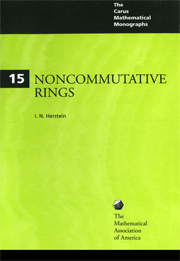4 - SIMPLE ALGEBRAS
Summary
Wedderburn's pioneer work on the structure of simple algebras set the stage for deep investigations—often with an eye to application in algebraic number theory—in the theory of algebras. Much of the early research, following on the heels of that of Wedderburn, came in the work of Dickson. Then in the 1920's and early 1930's a very deep investigation of simple algebras was carried out culminating in a beautiful structure theory for division algebras over algebraic number fields. A large part of the results was developed in the hands of Albert, Artin, Brauer, Noether and many others.
As is often the case in mathematics, the cycle swings back on itself. This lovely work on the theory of simple algebras has served as the inspiration for much work in the algebra of today. Now, in the setting of homological algebra, these results on simple algebras have been smoothed, restated, reinterpreted and extended to an extremely large setting. To see the particulars of this activity one should consult some of the papers we cite at the end, particularly those of Amitsur, Auslander, Chase, Harrison, Rosenberg, Serre and Zelinsky.
The Brauer group. We begin with a
Definition. An algebra A is said to be central simple over a field F if A is a simple algebra having F as its center.
Our concern shall be the nature of the set of simple algebras central over a fixed field F. Thus it is desirable to know what we can do to such algebras and still stay in the set.
- Type
- Chapter
- Information
- Noncommutative Rings , pp. 89 - 123Publisher: Mathematical Association of AmericaPrint publication year: 1968



